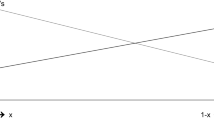Abstract
We consider the strategy-proof rules for reallocating individual endowments of an infinitely divisible good when agents’ preferences are single-peaked. In social endowment setting, the seminal work established by Sprumont (Econometrica 59:509–519, 1991) proves that the uniform rule is the unique one which satisfies strategy-proofness, efficiency, and envy-freeness. However, the uniform rule is not so appealing in our model since it disregards the differences in individual endowments. In other words, the uniform rule is not individually rational. In this paper, we propose a new rule named the uniform proportion rule. First, we prove that it is the unique rule which satisfies strategy-proofness, efficiency, and envy-freeness on proportion and we show that it is individually rational. Then, we show that our rule is indeed a member of the class of sequential allotment rules characterized by Barberà et al. (Games Econ Behav 18:1–21, 1997).
Similar content being viewed by others
Notes
An agent is a demander (respectively, supplier) whenever his endowment is strictly less (respectively, greater) than his peak. The formal definition is given in Sect. 2.
By feasibility, \( \lambda \) can be precisely computed as \( \lambda = \frac{E - \sum _ {i \in N^{*}(R)}p(R_i)}{\sum _ {j \notin N^{*}(R)}e_j}\).
This is based on the idea of an anonymous referee.
References
Barberà S, Jackson MO, Neme A (1997) Strategy-proof allotment rules. Games Econ Behav 18:1–21
Benassy JP (1982) The economics of market disequilibrium. Academic Press, New York
Ching S (1992) A simple characterization of the uniform rule. Econ Lett 40:57–60
Ching S (1994) An alternative characterization of the uniform rule. Soc Choice Welf 11:131–136
Foley DK (1967) Resource allocation and the public sector. Yale Econ Essays 7:45–98
Hashimoto K, Wakayama T (2021) Fair reallocation in economies with single-peaked preferences. Int J Game Theory 50:773–785
Klaus B (2001) Uniform allocation and reallocation revisited. Rev Econ Des 6:85–98
Klaus B, Peters H, Storcken T (1997) Reallocation of an infinitely divisible good. Econ Theory 10:305–333
Klaus B, Peters H, Storcken T (1998) Strategy-proof reallocation of an infinitely divisible good. In: Butzer PL, Jongen HTh, Oberschelp W (eds) Charlemagne and the liberal arts: 1200 years of civilization and science in Europe, volume 2: mathematical arts. Brepols Verlag, Aachen, pp 455–470
Kolm SC (1972) Justice et Équité. Editions du Centre National de la Recherche Scientifique, Paris
Mizobuchi H, Serizawa S (2006) Maximal domain for strategy-proof rules in allotment economies. Soc Choice Welf 27:195–210
Moreno B (2002) Single-peaked preferences, endowments and population-monotonicity. Econ Lett 75:87–95
Sakai T, Wakayama T (2012) Strategy-proofness, tops-only and the uniform rule. Theory Decis 72:287–301
Schmeidler D, Vind K (1972) Fair net trades. Econometrica 40:637–642
Sönmez T (1994) Consistency, monotonicity and the uniform rule. Econ Lett 46:229–235
Sprumont Y (1991) The division problem with single-peaked preferences: a characterization of the uniform allocation rule. Econometrica 59:509–519
Acknowledgements
We would like to thank an associate editor, two anonymous referees, Yuji Fujinaka, Kazuhiko Hashimoto, Osamu Hayashida, Kosuke Hirose, Tomoyuki Kamo, Toshiji Miyakawa, Akitoshi Muramoto, Shohei Tamura and Takuma Wakayama for helpful suggestions and comments. This research was partially supported by JSPS KAKENHI Grant Number 21K01384.
Author information
Authors and Affiliations
Corresponding author
Additional information
Publisher's Note
Springer Nature remains neutral with regard to jurisdictional claims in published maps and institutional affiliations.
Rights and permissions
About this article
Cite this article
Zhao, Z., Ohseto, S. Strategy-proof and fair reallocation with single-peaked preferences. Soc Choice Welf 58, 791–800 (2022). https://doi.org/10.1007/s00355-021-01374-3
Received:
Accepted:
Published:
Issue Date:
DOI: https://doi.org/10.1007/s00355-021-01374-3




